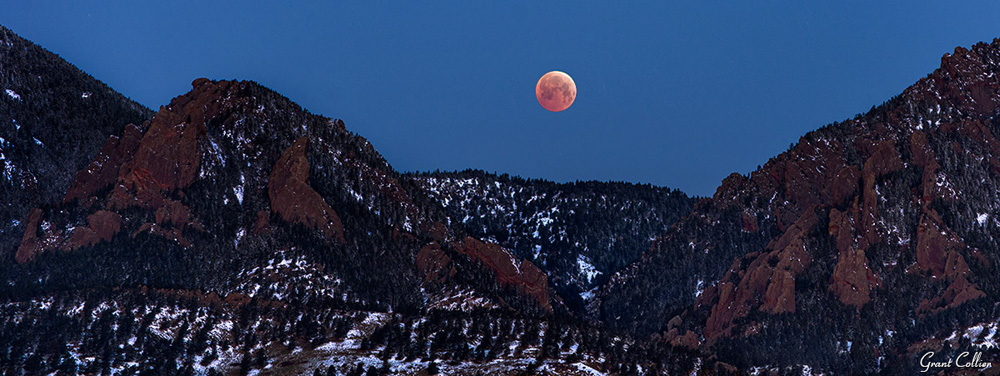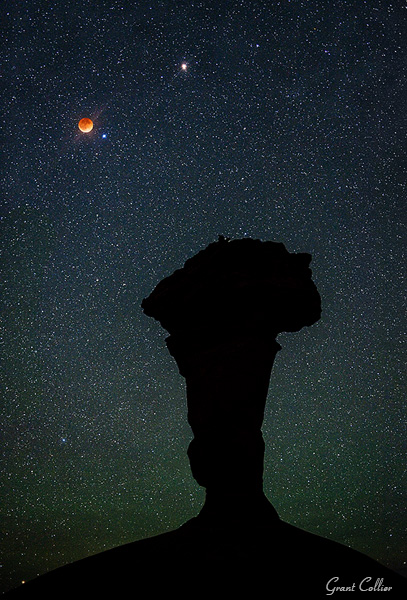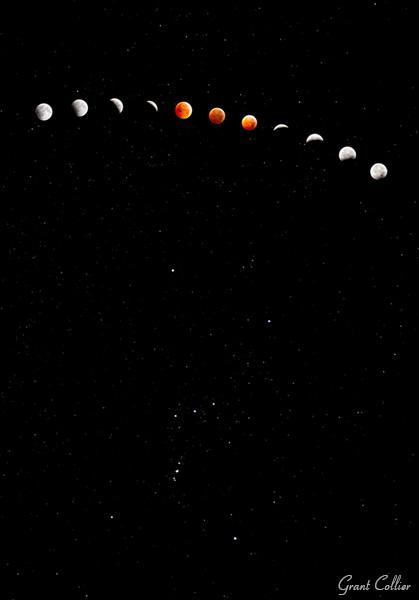Featured Products
When to photograph the upcoming eclipse:
In 2014 and 2015, we have been witness to a rare lunar tetrad, in which there have been four total lunar eclipses with no partial lunar eclipse occurring in between. The last of these four eclipses will occur on September 27, 2015. For those not inclined to stay up all night, this will be the easiest of the four eclipses to see and photograph, as it will occur shortly after sunset in North America.
What is an eclipse:
Lunar eclipses occur when the Earth passes directly between the sun and the moon at night. During the first part of the eclipse, you’ll see just a small part of the Earth’s shadow covering the moon. During a total lunar eclipse, this shadow will grow until it completely blocks the moon. During totality, some light that passes through Earth’s atmosphere will be refracted and still hit the moon. This refracted light will have a warm glow to it, and the moon will appear as an orange ball in the sky.

I captured this image of an eclipse over the Boulder Flatirons by combining two exposures – one for the moon and one for the rest of the scene. Exposure for moon: 280mm, f5.6, 1 sec, ISO 1600; exposure for rest of scene: 110mm, f5.0, 13 secs, ISO 1600.
How to photograph the eclipse:
A lunar eclipse is difficult to photograph because you need to keep your exposures to about one second or less or the moon will move too far during the exposure, causing it to blur. If you want to include any foreground objects in your image, this exposure length will usually not be long enough to capture good quality images of the scene. You’ll therefore need to blend two exposures – one short exposure for the moon and a longer exposure for the rest of the scene. I explain how to capture these images in my book “Collier’s Guide to Night Photography” and give a step-by-step demonstration on how to blend the images in Photoshop in my video called “Collier’s Guide to Post-Processing Night Photos.”
One time when you may be able to capture an eclipse and a foreground object in a single exposure is if the eclipse occurs during civil or even nautical twilight. At this time, there may be enough light on the foreground that you will be able to get good quality shots with the short exposures that are required to photograph the moon. For the September 27 eclipse, this may be possible if you live on the west coast of the Unites States or in western Canada. Otherwise, you’ll likely have to blend two exposures.

I captured this image shortly after I took the previous shot. By this time, it was a little lighter out, as the sun was about to rise. As a result, there was just enough light on the land to get a good exposure of both the moon and the mountains with a single exposure. 500mm, f6.3, 1 second, ISO 1600.
Another time you can capture an eclipse with a single exposure is if you are using a long telephoto lens and don’t include any foreground objects. In this case, I recommend using a remote shutter release and mirror lock-up on your camera. When using a telephoto lens, even the slightest vibration caused by the mirror going up can cause the image to blur. With the mirror lock-up on, the first time you hit the shutter release, it will move the mirror up and the second time you hit it, it will take the shot.
If you want very detailed images of an eclipse, you can use an equatorial mount. This device moves your camera along with the stars and lets you take much longer exposures without blurring the moon. The moon does move relative to the stars, but it moves at a much slower rate than the earth rotates. You can therefore take images of about 30 seconds without getting much blur in the moon or stars. You can’t include foreground objects when using an equatorial mount, as the movement will blur these objects. In this situation, you would again have to blend multiple exposures.

The moon was high in the sky during the total lunar eclipse on April 15, 2014. I had to find a tall rock formation in order to include both the moon and a foreground object in the shot. I again combined two exposures to capture this image. Exposure of moon: 85mm, f2.8, 1 second, ISO 500; exposure of rest of scene: 38mm, f2.8, 13 seconds, ISO 6400.
Another option when photographing an eclipse is to take images of many different stages of the eclipse, from the time it just begins to be covered by Earth’s shadow until the time it is almost out of Earth’s shadow. You can then create a composite image with many different moons at various stages. You can include a foreground object with the moons arcing above it or exclude the foreground and just include the moons in the night sky.
On September 27, it won’t be possible to create a composite of all stages of the lunar eclipse if you are in the western half of North America, as you won’t be able to see the beginning of the partial eclipse. However, it should be possible if you live in the eastern half of North America or in Western Europe.

To create this composite, I used Photoshop to combine images from all of the stages of a lunar eclipse into a single photograph.
Mark your calendars now, because If you miss this amazing event, you won’t be able to see another total lunar eclipse until 2018!
Grant Collier has been working as a professional photographer for 20 years and has been shooting photos at night for 12 years. He is the author of 11 books and has just released a new book called “Collier’s Guide to Night Photography in the Great Outdoors” and an instructional video called “Collier’s Guide to Post-Processing Night Photos.”
No Comments
Leave a Comment
You must be logged in to post a comment.







































Hello,Nice article! What camera do you reckon is best for photographing the lunar eclipse?